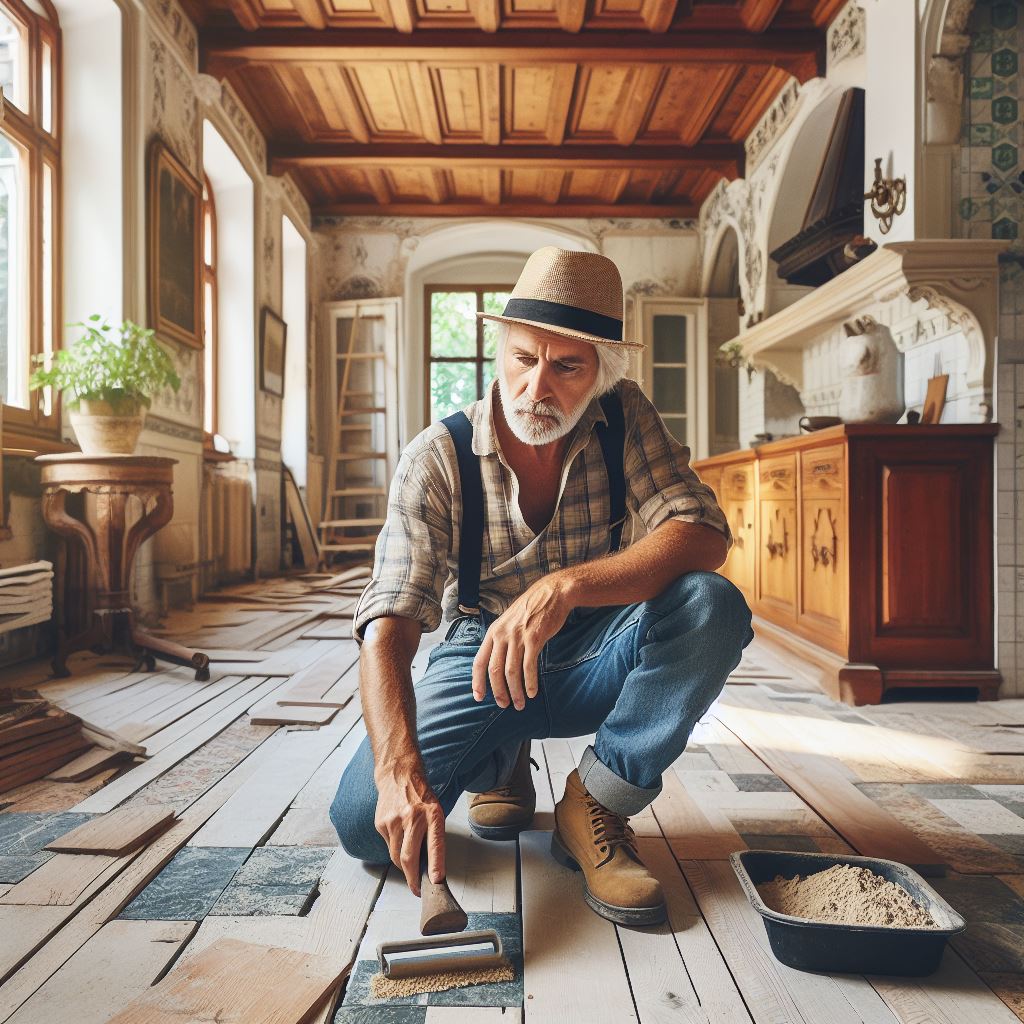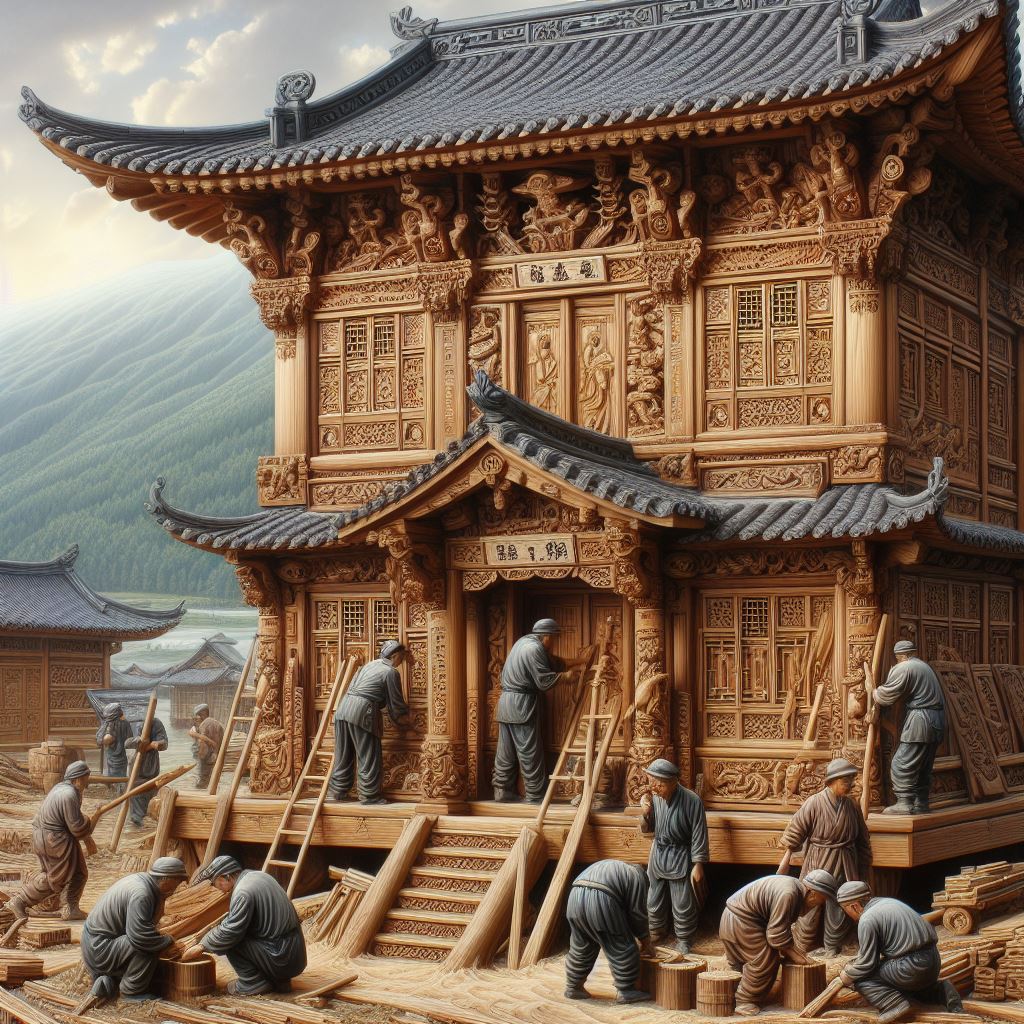Introduction
Historic flooring plays a significant role in the value and aesthetics of real estate properties.
It adds character and charm to a space, reflecting the history and craftsmanship of a bygone era.
However, when it comes to preservation, the question arises: should historic flooring be repaired or replaced?
Preserving historic flooring is crucial not only for maintaining the authenticity of a property but also for safeguarding its historical significance.
These floors often bear witness to important events and tell stories that are etched in their unique patterns and designs.
Restoring them to their original glory can be a laborious and time-consuming process, but the rewards are undeniable.
Repairing historic flooring involves meticulous attention to detail and skilled craftsmanship.
By addressing specific areas of damage, such as cracks, chips, or loose boards, while preserving the original material, the floor’s integrity can be maintained.
This approach respects the history and minimizes the loss of the original flooring.
On the other hand, there are instances when replacing historic flooring becomes necessary.
Irreparable damage, severe decay, or structural instability may deem restoration impractical or even hazardous.
In such cases, carefully selecting replacement materials that closely match the original design and character of the floor becomes crucial.
Ultimately, the decision to repair or replace historic flooring depends on various factors, including the extent of damage, available resources, and the property owner’s priorities.
Balancing the preservation of history with the practicality of modern-day use is essential to ensure the longevity and relevance of historic flooring in the ever-evolving real estate market.
In the sections that follow, we will delve deeper into the considerations involved in repairing or replacing historic flooring, exploring both the technical aspects and the preservation principles that guide these decisions.
Stay tuned to gain a comprehensive understanding of this compelling topic.
Understanding Historic Flooring
Definition and significance of historic flooring
Historic flooring refers to the original flooring materials used in buildings that have historical and cultural significance.
It serves as a reflection of the era it was installed and adds to the overall aesthetic and charm of the space.
Different types of historic flooring materials
- Hardwood flooring: Commonly found in historic buildings, hardwood floors provide a classic and timeless look.
- Terrazzo flooring: Made from a mixture of marble, granite, glass, or other aggregates, terrazzo floors offer durability and a unique pattern.
- Mosaic flooring: Created by arranging small colored tiles to form intricate designs, mosaic floors are often found in historical landmarks, churches, and museums.
Importance of preserving historic flooring for historical and cultural value
- Historical value: Historic flooring provides a tangible link to the past, allowing us to understand the architectural styles and craftsmanship of previous eras.
- Cultural value: These flooring materials represent cultural traditions and can highlight the cultural diversity of a particular region or country.
- Educational value: Preserving historic flooring allows future generations to learn about the history, design, and techniques of the time period in which it was created.
- Aesthetics: Historic flooring adds character and authenticity to a space, enhancing its overall beauty and charm.
- Economic value: Buildings with well-preserved historic flooring often attract tourists and visitors, boosting local economies and preserving the city’s historical identity.
In essence, understanding historic flooring is crucial for recognizing its significance and preserving it for future generations.
By appreciating the different types of materials used and their historical and cultural value, we can ensure the protection and maintenance of these unique flooring treasures.
Read: Expert Advice: Consulting Preservationists
Factors to Consider Before Making a Decision
When faced with the task of dealing with historic flooring, one of the biggest decisions to make is whether to repair or replace it.
This decision should never be taken lightly, as it can greatly impact the overall preservation of the historical integrity of a building.
Condition of the historic flooring
The first factor to consider is the condition of the historic flooring. Is it merely showing signs of wear and tear, or is it severely damaged?
If the flooring is simply in need of minor repairs, it may be more cost-effective and practical to opt for repair rather than replacement.
Type, age, and rarity of the flooring material
Another important consideration is the type, age, and rarity of the flooring material. Is it a unique material that cannot be easily replicated?
Does it hold significant historical value? If so, preserving the original flooring should be a priority and repairing it may be the best choice.
Preservation guidelines and regulations
Preservation guidelines and regulations set by historical societies or governmental agencies should also be taken into account.
These guidelines often dictate the level of preservation required for historic structures.
In some cases, replacing the flooring may not even be an option due to strict regulations.
Cost considerations
Cost is always a factor to consider when making any decision, including whether to repair or replace historic flooring.
Repairs may be more affordable in the short term, but it’s important to consider the long-term costs as well.
Will the repairs hold up over time, or will they require additional maintenance in the future?
On the other hand, replacing the flooring may come with higher upfront costs but could potentially save money in the long run.
Expected lifespan of repaired flooring versus new replacement
The expected lifespan of the repaired flooring versus a new replacement should also be taken into account.
If the repairs can extend the lifespan of the flooring significantly and maintain its historical value, it may be worth choosing repair over replacement.
However, if the repairs are only temporary solutions and the flooring will continue to deteriorate, replacement may be the better option for long-term preservation.
In fact, when deciding whether to repair or replace historic flooring, it’s crucial to consider various factors.
These include the condition of the flooring, the type and rarity of the material, preservation guidelines, cost considerations, and the expected lifespan of repairs versus replacement.
By carefully weighing these factors, one can make a well-informed decision that ensures the preservation of historical integrity for future generations to appreciate.
Pros of Repairing Historic Flooring
Retaining the original character and charm of the property
Repairing historic flooring allows you to preserve the unique character and charm of the property.
The original flooring often adds a sense of history and authenticity to the space.
By repairing instead of replacing, you can maintain the historic integrity of the property.
Preserving historical authenticity
Historic flooring tells a story and contributes to the overall historical authenticity of the property.
Repairing the original flooring ensures that the property remains true to its historical roots.
Many historic buildings have specific requirements for preservation, including the retention of original flooring.
Cost-effectiveness compared to replacement
Repairing historic flooring is often more cost-effective than replacing it entirely.
Replacement can be expensive, especially when dealing with unique or hard-to-find materials.
By repairing damaged areas, you can save money while still maintaining the overall integrity of the flooring.
Lesser environmental impact
Repairing historic flooring reduces the need for new materials, thus minimizing environmental impact.
Choosing repair over replacement helps to conserve resources and reduce waste.
By opting for repair, you contribute to a more sustainable approach to historic preservation.
In short, repairing historic flooring offers several advantages.
It allows you to retain the original character and charm of the property, preserving its historical authenticity.
Additionally, repairing is often more cost-effective than replacing the flooring entirely, and it has a lesser environmental impact.
By carefully considering the pros and cons, you can make an informed decision about whether to repair or replace historic flooring.
Read: Old Home Safety Checks Pre-Renovation
Cons of Repairing Historic Flooring
Difficulty in finding matching materials
- Finding materials that match the historic flooring can be challenging and time-consuming.
- Matching the color, texture, and pattern of the original flooring may require extensive research.
- Sometimes, the materials used in the past are no longer readily available in the market.
- Obtaining the exact same materials can be expensive and may add to the overall cost of repairs.
Potential for hidden damage or structural issues
- Older flooring often hides underlying damage, such as rot, termite infestations, or structural issues.
- Repairing the flooring without addressing these hidden problems can lead to further deterioration in the future.
- It is essential to conduct a thorough inspection to identify any potential issues before starting repairs.
- Unchecked structural issues can compromise the safety and stability of the entire building.
Limited repair options for severely damaged floors
- Historic flooring that is severely damaged may have limited options for repair.
- Some damages, like large holes, deep scratches, or extensive decay, may be beyond repair.
- Restoration experts may not be able to replicate the original flooring’s intricate designs or patterns.
- In such cases, complete replacement of the flooring might be the only feasible option.
Shorter lifespan compared to replacing with new flooring
- Repairing historic flooring may extend its lifespan, but it might not match the durability of new flooring.
- Even with proper restoration, the repaired flooring might show signs of wear and tear sooner than expected.
- Historic flooring experiences natural deterioration due to age, which cannot be fully reversed through repairs.
- Eventually, replacing the entire floor might be necessary to ensure long-term functionality and aesthetics.
Read: Historic Window Restoration Techniques

Pros of Replacing Historic Flooring
Ability to choose modern materials with improved durability and functionality
Choosing to replace historic flooring provides the opportunity to select from a wide range of modern materials.
These materials often offer improved durability and functionality compared to traditional options.
Avoid potential hidden damage or underlying issues
By opting for a full replacement, homeowners can avoid potential hidden damage or underlying issues that may be present in old historic flooring.
This allows for a fresh start and ensures a solid foundation for the new flooring.
Easier maintenance and cleaning
Replacing historic flooring with new materials can significantly simplify the maintenance and cleaning process.
Modern flooring options often require less effort and specialized products, making it easier for homeowners to keep their floors looking pristine.
Longer lifespan compared to repaired flooring
In many cases, a completely replaced historic flooring can have a longer lifespan compared to repaired flooring.
This is due to the fact that the new materials used in replacement are typically more resistant to wear and tear, resulting in increased longevity.
Enhanced aesthetics and customization options
Replacing historic flooring allows for enhanced aesthetics and customization options.
Homeowners can choose from a variety of designs, patterns, and colors to match their personal style and complement the overall interior decor.
Improved insulation and energy efficiency
Modern flooring materials often offer improved insulation and energy efficiency, providing better temperature regulation within the home.
This can lead to reduced energy consumption and lower utility bills, making it a cost-effective choice in the long run.
Increased property value
Investing in the replacement of historic flooring can significantly increase the property value.
Potential buyers are more likely to be attracted to a home with well-maintained, high-quality flooring, resulting in a higher resale value and potentially faster sale.
Opportunity for design innovation
Replacing historic flooring opens up opportunities for design innovation.
Homeowners can explore unique patterns, materials, and layout options that may not have been available during the time the original flooring was installed.
Health and safety considerations
Outdated historic flooring may contain hazardous materials such as asbestos or lead.
By replacing the flooring, homeowners can eliminate these health risks and create a safer living environment for themselves and their families.
Addressing structural integrity issues
Full replacement allows for the correction of any structural integrity issues in the flooring.
This ensures a stable and level surface, preventing any potential accidents or further damage to the property.
Replacing historic flooring offers numerous benefits, including the ability to choose modern materials, avoiding hidden damage, easier maintenance, longer lifespan, enhanced aesthetics, improved insulation, increased property value, design innovation, health and safety considerations, and addressing structural integrity issues.
Read: Renovation Tax Credits for Historic Homes
Cons of Replacing Historic Flooring
In this chapter, we will delve into the cons of replacing historic flooring. While there are certainly advantages to a fresh and updated foundation, it is crucial to consider the potential drawbacks.
Loss of historical authenticity and charm
Historic flooring carries a unique sense of authenticity and charm that cannot be easily replicated.
These floors often boast intricate designs and craftsmanship, showcasing the style of the era they were constructed in.
By replacing them, this historical uniqueness is lost forever.
Replacing historic flooring can result in the loss of the unique characteristics and charm that make older floors special.
These floors often have a story to tell and replacing them erases that history.
Potential conflict with preservation guidelines and regulations
When replacing historic flooring, it is essential to consider preservation guidelines and regulations.
Many historic properties have strict rules regarding the preservation of original features, including flooring. Replacing them could lead to legal conflicts.
Before making any decisions about replacing historic flooring, it is crucial to consult preservation guidelines and regulations.
These guidelines are in place to ensure the preservation of original features and maintain the historical integrity of the property. Ignoring them can result in legal issues and public disapproval.
Higher cost compared to repairs
Replacing historic flooring is generally more expensive than repairing it.
The cost of purchasing new materials and hiring professionals for installation can quickly add up.
This can be a significant drawback for property owners on a tight budget. Replacing historic flooring can be a costly endeavor.
The expense involved in purchasing new materials, such as reclaimed wood or custom tiles, along with professional installation, can quickly deplete a budget.
In contrast, repairing existing flooring tends to be more budget-friendly.
Higher environmental impact
The replacement of historic flooring contributes to a higher environmental impact.
The production, transportation, and disposal of new flooring materials have negative consequences for the environment.
Choosing to replace rather than repair may not align with sustainability goals.
The replacement of historic flooring has a higher environmental impact compared to repairs.
The production and transportation of new flooring materials contribute to carbon emissions, while the disposal of old flooring adds to landfill waste.
By opting for repairs, we can reduce our carbon footprint and limit waste generation.
In general, the decision to replace historic flooring should be carefully considered before proceeding.
While it may seem tempting to have a clean and modern floor, the loss of historical authenticity, potential conflicts with preservation guidelines, higher costs, and environmental concerns should not be taken lightly.
It is essential to weigh these cons against the benefits and explore alternative options, such as repairs or restoration, to preserve the unique charm and heritage of historic flooring.
Case Studies and Examples
Successful historic flooring repairs
- An old Victorian home in Boston had its original hardwood floor repaired, restoring its charm.
- A historic courthouse in Charleston had its damaged marble tiles repaired, preserving its grandeur.
- By carefully patching and refinishing the hardwood floor in a colonial house, its character was revived.
- The wooden parquet flooring in a Tudor-style mansion was meticulously repaired, revealing its intricate design.
- A historic hotel in New Orleans restored its ornate mosaic tiles, honoring its rich history.
Historic flooring replacements and their impact
- A farmhouse from the early 1800s opted for laminate flooring, compromising its authenticity and value.
- Replacing the original terrazzo floor with vinyl in a mid-century modern building diminished its aesthetic appeal.
- An Art Deco apartment complex replaced its original mosaic tiles with modern ceramic tiles, losing its unique style.
- Installing faux wood tiles instead of restoring the original hardwood floor in a Craftsman home altered its character.
- Replacing the historic brick pavers with concrete in a historic square diminished its historical significance.
Tales of regrets or successes from homeowners/property owners
- A homeowner regrets replacing the original historic tiles in their colonial house since it reduced its value and charm.
- A property owner successfully repaired the historic parquet flooring in their Victorian mansion, adding value to the property.
- An owner of a historic inn regrets replacing the original hardwood floors as it altered the ambiance of the establishment.
- A homeowner takes pride in the decision to repair their original terrazzo flooring, enhancing the authenticity of their home.
- A property owner shares their success story of restoring the historic mosaic tiles in their commercial building, attracting more visitors.
Conclusion
In wrapping up, let’s delve into the nuanced world of historic flooring decisions.
Repairing breathes life into the past but dances on the edge of structural compromise.
On the flip side, replacing ensures longevity but risks altering the very essence of original aesthetics.
The key lies in meticulous evaluation – a careful dance between preserving the historical tapestry and addressing practical concerns.
As we bid adieu to this exploration, remember the importance of thorough consideration.
Balance the delicate interplay of pros and cons, placing preservation values on a pedestal.
For those traversing this intricate path, consulting with experts or professionals in the realm of historic preservation becomes paramount.
Their seasoned advice acts as a guiding beacon, illuminating the fine line between conservation and practical necessity.
In the realm of historic flooring, it’s not merely a decision; it’s a delicate art form that requires expertise to strike the right chord.




